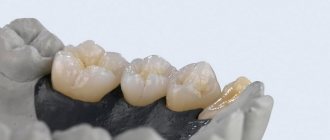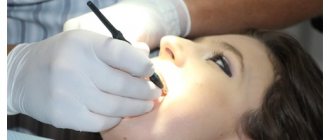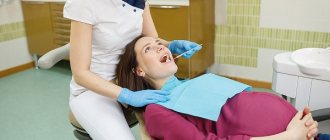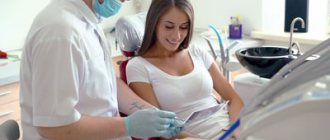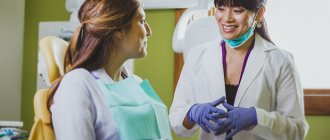Double beauty
Pregnancy is a wonderful time in a woman’s life. But often expectant mothers, as well as young mothers breastfeeding, are upset by the presence of many restrictions in all areas of life - from nutrition to sports and recreation. In particular, there are many prohibitions in the matter of self-care. But you really want to be beautiful during this magical period of your life, and modern women are usually not ready to just give up going to a cosmetologist and using a variety of cosmetics for several years.
Fortunately, it is not at all necessary to wrap yourself in a burqa for this entire period and use exclusively baby cream and a cucumber mask. Let's, together with the cosmetologist of the EuroMed Clinic, Svetlana Mikhailovna Lexandrova, figure out what is actually prohibited during this period and what is not.
When does Botox start to work after injections?
Many patients, before this cosmetic procedure, are concerned about the question of how long it takes for Botox to work after introducing the drug under the skin. This topic is relevant for those clients of a cosmetologist who are sure that they can leave the clinic only when the effect of Botox appears. In fact, there is no immediate blockade of the neuromuscular motor impulse after administration of the drug. Typically, noticeable results gradually increase over 3-5 days after injections.
Today, the cosmetology market also offers a popular analogue of Botox – the French drug Dysport, which exhibits a pronounced effect already on the first day after the procedure.
At the same time, when Botox begins to act, it is not at all necessary to remain under the supervision of a doctor, since the effect can be gradually adjusted over three months, after the first use of botulinum therapy, and the most expressive final result can be achieved only after 2 weeks. After this period, it is recommended to undergo an examination with your cosmetologist. The doctor will evaluate the result and, if necessary, “fill in” the missing dose of the drug. Thus, your cosmetologist accurately selects your dose of Botox. It depends how long it takes for Botox to start working, primarily on the individual characteristics of the patient’s metabolism.
Hair care
There is an unusually persistent myth that pregnant women should not cut or dye their hair.
Where it came from is now difficult to understand, but nevertheless, in the antenatal clinic you will definitely meet several expectant mothers with noticeably grown hair roots and a haircut that has lost all shape. There is no scientific evidence that cutting or dyeing hair with modern gentle hair dyes can harm a pregnant woman or unborn child. Therefore, forget about grandma’s fears and feel free to go to the beauty salon! The only caveat is that don’t forget that after the birth of your baby, you most likely won’t have time for a hairdresser in the first months, so closer to the birth, get a haircut that will be easy to care for when you’re short on time.
Second trimester - needs increase
By about 14-15 weeks, the woman’s well-being returns to normal - toxicosis goes away, physical and emotional activity increases. The baby begins to produce blood cells, strengthens bone tissue, the pituitary gland begins to work, the first hair and nails appear, bone mineralization progresses, and muscles begin to contract. To meet the increased needs of the child, the mother needs to eat more. At the same time, it is not the caloric intake that needs to be increased, but the amount of nutrients. At this time, both organisms need vitamin D, calcium, and iron.
Mandatory foods in the diet:
• to provide calcium - cheese, cottage cheese, milk, almonds, sesame seeds; • sources of vitamin D - fatty fish, cod liver, eggs, butter, flaxseed, olive oil; • for the prevention of iron deficiency - beef and pork liver, cocoa, beans, cabbage, apples, blueberries, greens (spinach, parsley, mint). In the second trimester, it is important to control the amount of table salt and fluid you drink. This will help avoid surges in blood pressure and cardiac overload. Recommended values: calories - 2800-3000, proteins - 120 g, fats - 85 g, carbohydrates - 400 g.
Manicure and pedicure
Can! You can do a manicure, you can do a pedicure, you can paint your nails and remove polish - all this will not affect your baby’s health in any way. The only thing is to be doubly attentive to the sterility of the instruments that the master uses - because now you are responsible not only for yourself, but also for the health of the unborn child. Although, to be honest, it’s unlikely that you, even if you weren’t pregnant, would agree to catch any unpleasant infection because of unsterile instruments.
By the way, keep in mind that almost all maternity hospitals require that the woman in labor not have nail polish. This often surprises women, but in fact such a wish makes sense. During childbirth, a variety of unforeseen situations are possible, and one of the symptoms signaling a problem is the condition of the nails. If your nails begin to turn blue, this indicates problems with the cardiovascular and respiratory systems. Perhaps you shouldn’t risk your health for bright marigolds in such a situation.
Difficult first trimester
The female body adapts to new conditions. Fatigue, drowsiness, and unstable mood are typical for a pregnant woman. There are problems with urination and bowel movements, acute reactions to tastes and smells. And at this time, the foundation of the baby’s health is laid. His nervous and circulatory systems are formed, and his heart begins to work intensively. Proper nutrition in the first trimester is a way to stabilize the mother’s condition and mitigate the risks of intrauterine anomalies.
Principles for creating a diet in the 1st trimester:
• Don't be greedy. Overeating increases the symptoms of toxicosis and provokes digestive failure. You need to eat in modest portions at intervals of 3-3.5 hours. • Take care of “building materials”. The basis for the formation of fetal cells is protein. From it the body receives 20 essential amino acids that it cannot produce on its own. The menu should include lean meat - turkey, chicken, veal. Twice a week you need to eat fish, alternating low-fat varieties (pollock, cod) with fatty ones (salmon, pink salmon, salmon). • “Agree” with the intestines. The problem for many women at the beginning of pregnancy is constipation. Fiber, which is found in raw vegetables, hard fruits, and bran, helps to cope with them. • Replenish supplies. During the formation of the nervous system, the baby squeezes iodine and B vitamins from the mother’s body. To prevent vitamin and mineral deficiency, shrimp, squid, seaweed and cauliflower, buckwheat porridge, eggs, and nuts should be introduced into the diet. • Do not experiment with drinks. It is recommended to drink water - still bottled or filtered. Adding freshly squeezed lemon juice will help calm nausea.
Daily caloric intake is 2500-2700. Nutrient distribution: proteins - 110 g, carbohydrates - 350 g, fats (vegetable + animal) - 75 g.
Cosmetics
It is forbidden
Products with retinoids are strictly prohibited during pregnancy, breastfeeding and three months before a planned pregnancy - they can have a teratogenic and embryotoxic effect, that is, negatively affect the fetus and increase the risk of congenital malformations. Therefore, products with retinoids are prescribed only if there is a negative pregnancy test and reliable contraception.
It is undesirable to use drugs containing acids during pregnancy. These are quite aggressive agents, and during pregnancy they can cause an unpredictable reaction: irritation, pigmentation disorders (lightening of some areas or, conversely, the appearance of dark spots), etc.
You should not use creams containing hormones (usually these are cosmetics that fight the signs of aging), because the body already undergoes powerful hormonal changes during pregnancy and lactation; you should not additionally load it.
Need to!
Be sure to use sunscreen during pregnancy. This is due to the fact that hormonal changes in the body often provoke the development of hyperpigmentation. And the sun's rays make this problem worse.
Remedies against stretch marks. Striae or stretch marks are such an unpleasant phenomenon that it is much easier to prevent than to get rid of it later. Be sure to use good anti-stretch mark creams from the very beginning of pregnancy, applying them with massaging movements to problem areas: chest, shoulders, abdomen, hips, buttocks. By the way, stretch marks often appear after childbirth, during lactation - after all, a nursing woman’s breasts can increase by several sizes compared to their normal state. Therefore, do not forget about the prevention of stretch marks throughout the entire period of breastfeeding.
How does Botox work after injection?
Botox is a cosmetic drug that contains weakened botulinum toxin. This substance is produced during the life of the bacterium Clostridium botulinum. Scientists have learned to use the special properties of botulinum toxin in cosmetology practice, with the goal of radical rejuvenation of the face and neck.
Botox is administered through subcutaneous injections into the area where expression lines are concentrated - the most unpleasant primary sign of aging. Penetrating into the fibers of the facial muscle, botulinum toxin blocks the mechanism of neuromuscular transmission, causing inhibition of a particular muscular structure of the face. Why is this necessary? Unlike other muscles, the facial muscles are in close contact with the skin, ensuring its tension. When a muscle is exposed to a toxin, it completely relaxes, which leads to the smoothing of the skin attached to it. Visually, this is manifested by the complete smoothing of facial wrinkles and skin creases of varying depths, which transforms and rejuvenates the patient’s face.
As a result of such a radical effect, a person loses the ability to control the muscle. However, contrary to popular belief, the face does not look like an artificial mask at all, which is due to the selective technique of administering the drug. Simply put, the static nature of one individual muscle is completely unnoticeable against the background of active facial movements of the surrounding facial muscles. This is why Botox injections can only be done in a good clinic. Only an experienced cosmetologist will accurately select the area of injection of the drug to achieve the desired result. The doctor performing botulinum therapy must undergo special training and have good experience, otherwise the result may be disastrous.
Speaking about the mechanism of action of Botox after administration, one cannot fail to note the fact that botulinum toxin has temporary activity. In the process of metabolism and enzymatic reactions, the toxin is gradually eliminated from the body, weakening the effect on the muscles and returning the former facial expressions. This can be considered both a positive feature, because the patient does not have to worry about the irreversibility of the effect, and a negative one, due to the need to re-administer the drug to maintain the anti-aging effect.
Salon treatments
Many people forget the way to a cosmetologist as soon as they see two lines on the test. This is a completely unnecessary sacrifice! Yes, there are certain procedures that are not recommended during pregnancy, but most skincare programs are quite affordable and will help maintain your beauty during this wonderful period. Just remember to notify the cosmetologist about your interesting situation, and the doctor will offer you suitable care.
It would also be a good idea to consult with the obstetrician-gynecologist who is caring for your pregnancy.
It is forbidden
- Procedures associated with a sharp change in temperature: cryosauna, hot wrap, etc.
- Hardware stimulating procedures can provoke contraction of the uterine muscles.
- Laser procedures and photorejuvenation.
- Injection techniques.
Massage
There is a widespread belief that pregnant women should not receive massage. In fact, it is possible, but only if the massage therapist has the appropriate qualifications. Regular massage can cause undesirable consequences. But a special massage for pregnant women, on the contrary, will significantly improve your well-being and condition. During this difficult period, when increasing weight, swelling, increased stress on the back and legs can cause many unpleasant moments, an experienced massage therapist will be of great help.
The main thing to remember is to be less nervous, don’t let meaningless restrictions poison your life and enjoy every moment of your magical state!
Where is Botox injected?
Botox injections are performed using ultra-thin needles, which avoids trauma to the skin and unsightly specific marks. The drug, as already mentioned, is injected into the area of localization of pronounced facial wrinkles.
- Forehead. Most often, injections are made in the frontal area, since Botox is effective in combating vertical wrinkles between the eyebrows, as well as smoothing deep horizontal frontal furrows;
- Eyes and lips. The introduction of Botox into the periorbital and perioral plane of the face will eliminate small expression wrinkles in the corners of the eyes and lips, which are popularly called “crow’s feet”;
- Neck area. Botulinum toxin therapy for the neck is rarely used, but with sufficient qualifications of the doctor, it can maximally correct age-related changes in the neck muscles;
- Nose. So-called “anger lines” on the bridge of the nose can also be corrected with botulinum injections.
Much less often, beauty injections are used to correct facial wrinkles in the lower third of the face, since in this case there is a risk of drooping (sagging) of the muscles that hold the facial contour. That is why the qualifications of the specialist who carries out this procedure are very important here.
Such injections do not cause discomfort to the patient himself, due to the fact that the skin is pre-treated with a local anesthetic solution. In the technique of botulinum injections, it is very important that the specialist correctly determines the area of injection of the drug, since the effectiveness of the procedure will ultimately depend on this factor. In order to eliminate the possibility of error, the doctor may ask the patient to grimace and twist during the procedure in order to determine the area where the largest number of facial folds of skin accumulate.
Which Botox is better to inject?
The modern cosmetology market offers several drugs that contain botulinum toxin type A. The most popular, in addition to the world-famous American Botox, can also be considered the French drug Dysport. The main differences between these products are the dosage of botulinum toxin, as well as the speed of formation and duration of the final effect. An experienced cosmetologist will help you choose the most suitable drug for yourself, but most experts recommend giving preference to the classic American Botox from the Allergen company, due to the greater knowledge of this product.
Effect of pregnancy on kidney function
Renal blood flow increases and glomerular filtration increases (maximum in mid-pregnancy) - associated with the excretion of metabolic products of the woman and the fetus.
The permeability of the kidneys to protein and carbohydrates increases: proteinuria (protein in the urine), glucosuria. The excretion of 140 mg/day of glucose in the urine is considered the upper limit of the physiological norm. Peak glucose secretion was detected at 9 months of pregnancy.
The peristaltic function of the ureters is sharply suppressed, as a result of which they expand and urine is retained in them. Atony of the ureters leads to impaired drainage of urine from the pelvis, which creates favorable conditions for the development of pyelonephritis in pregnant women. In the postpartum period, these phenomena soon disappear.
Is Botox harmful to health?
The question regarding the harms and benefits of Botox remains one of the most pressing for patients who have decided to undergo botulinum rejuvenation. The mechanism of action of the drug frankly frightens the majority of patients, who most often, as practice shows, fear paralytic effects on the surrounding muscles, distortions and drooping of facial muscles and other aesthetic problems. There is absolutely no need to worry about this, since the composition of botulinum preparations is absolutely safe and does not cause complications or side effects.
Such fears fuel unreliable Internet stories and myths about Botox, which, despite the drug being studied, continue to be passed on, as they say, “from generation to generation.” In fact, according to statistics, aesthetic harm from Botox occurs in only 0.14% of patients and is caused only by violations of the drug administration technique. Possible complications also include the following conditions:
- pain in the injection area occurs in 1.3% of patients;
- no more than 2% of people experience mild headaches;
- small hematomas at the injection site occur in 6% of patients only due to the fault of the specialist;
- temporary loss of sensitivity in the injection area is observed in less than 1% of cosmetologist’s clients;
- About 1% of the population is allergic to the drug;
- Infectious contamination of the injection site is extremely rare and is a consequence of non-compliance with the requirements of asepsis and antisepsis during the procedure.
All complications are exclusively temporary and disappear as botulinum toxin is removed from the patient’s body. When discussing unsuccessful botulinum therapy procedures, one cannot help but note that there is a small percentage of people (1-2%) who are resistant to the effects of this toxin and the procedure in this case does not allow achieving a rejuvenating effect.
Effect of pregnancy on liver function
The liver during pregnancy is in a state of high functional tension. However, in healthy women during the physiological course of pregnancy, the functioning of the liver is not impaired.
Noted:
- slight increase in liver size in the absence of pronounced histological changes;
- there is a decrease in the antitoxic function of the liver;
- the level of protein in the blood serum decreases, by the time of childbirth it can reach 60 g/l;
- the result of changes in the composition of serum proteins is an increase in ESR;
- blood clotting and fibrinolysis changes. These changes help increase blood clotting ability.
How long does the effect of Botox last?
How effective Botox is is perhaps one of the most frequently asked questions. Here it should be understood that there simply cannot be an unambiguous answer to this question, since the duration of local muscle relaxation will, like the speed of achieving the effect, directly depend on the metabolic functions of the body, more simply, on the metabolic rate. However, experts say that after the first administration of the drug, the average duration of action of Botox will be from 4 to 6 months.
Also, speaking about the duration of action of Botox, it is simply impossible not to mention the increased effectiveness of the drug with repeated administration. Repeated injections show a significantly longer lasting effect, which can range from 8 to 12 months. In addition, regular use of botulinum therapy often gives the cosmetologist the opportunity to reduce the dosage. This is largely explained by the fact that being stationary for a long time, the facial muscle loses the “habit” of actively moving, and a person loses the habit of “frowning,” which reduces the load on the facial muscles and the severity of wrinkles.

